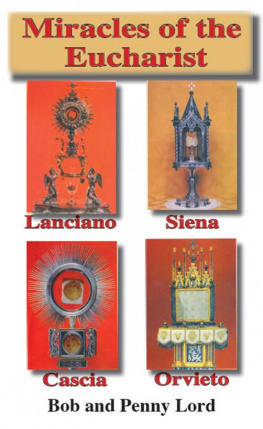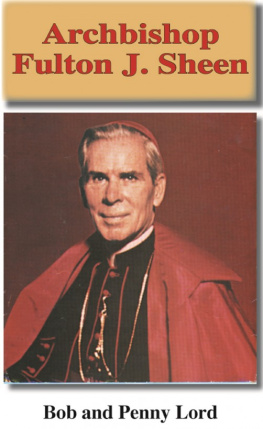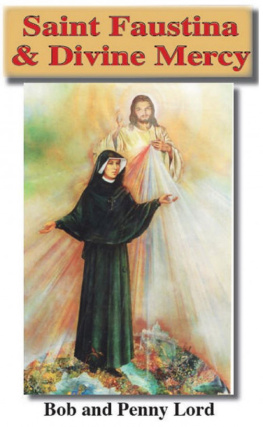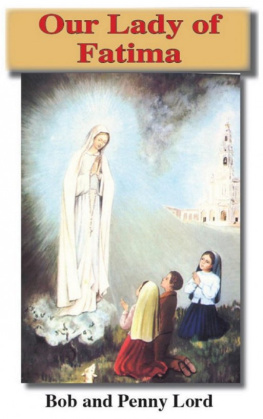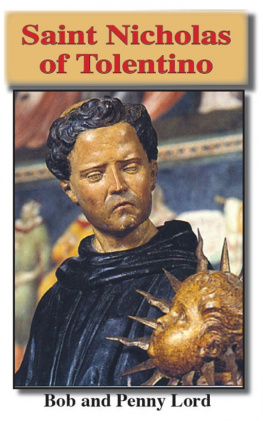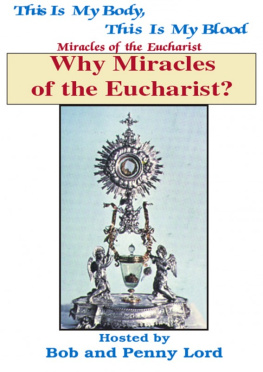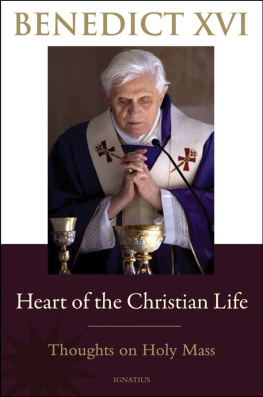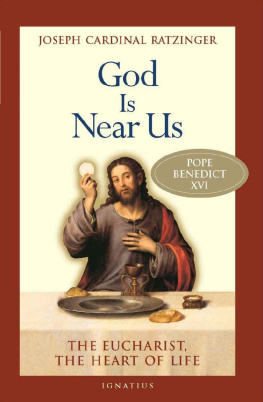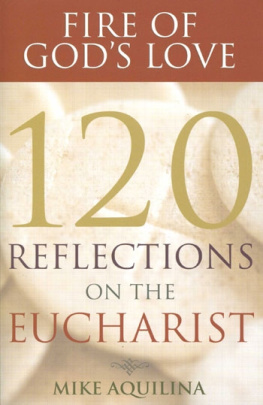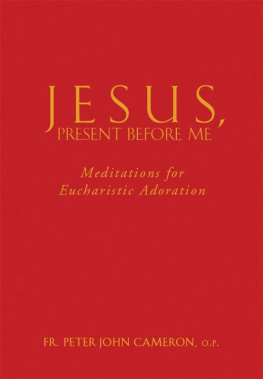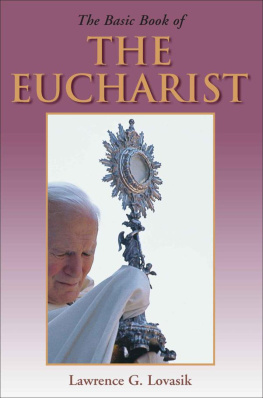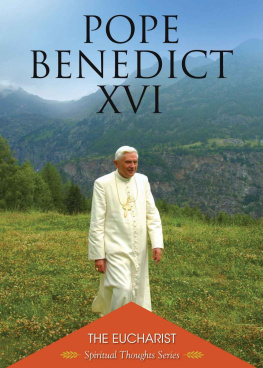
Miracles of the Eucharist of Lanciano -Cascia - Siena - Orvieto
Bob and Penny Lord
Published by Bob and Penny Lord atSmashwords
Copyright 2010 Bob and Penny Lord
Discover other titles by Bob and Penny Lordat http://www.smashwords.com/profile/view/bobandpennylord
This ebook is licensed for your personalenjoyment only. This ebook may not be re-sold or given away toother people. If you would like to share this book with anotherperson, please purchase an additional copy for each recipient. Ifyou are reading this book and did not purchase it, or it was notpurchased for your use only, then please return to Smashword.comand purchase your own copy. Thank you for respecting the hard workof the author.
Miracles of the Eucharist of Lanciano -Cascia - Siena - Orvieto
Miracle of the Eucharist of Lanciano
Lanciano is a small, medieval town , nestledin from the coast of the Adriatic Sea in Italy, halfway between SanGiovanni Rotondo and Loreto. Everything about Lanciano smacks ofthe Eucharistic Miracle. Even the name of the town was changed fromAnxanum (in ancient times), to Lanciano, meaning THE LANCE.Tradition has it that the centurion, named Longinus, who thrust theLance into the side of Jesus, striking Him in the Tip of His Heartfrom which He shed blood and water, (in the Gospel account of theCrucifixion (Mk 15:29)) was from this town. After seeing the eventswhich followed the piercing of Jesus heart, the darkening of thesun, and the earthquake, he believed that Christ was the Savior. Amore physical sign, however, was that Longinus had had pooreyesight, and after having touched his eyes with the water andblood from the side of Jesus, his eyesight was restored. What aperfect parallel the actions of the Centurion were to theEucharistic Miracle. He touched the Heart of Jesus, was healed, andconverted. He gave up the Army, went to Cappadocia, and wasmartyred for the faith. He is known now as Saint Longinus. Hisfeast day is celebrated on March.
The church of the Eucharistic Miracle islocated in the center of the town. But what is the center of thetown today was the outskirts of the town back in the EighthCentury, when the Eucharistic Miracle occurred. At the time, it wascalled the Church of St. Legontian and St. Domitian, and was underthe custody of the Basilian Monks, of the Greek Orthodox Rite. Thiswas prior to the Great Schism of 1054.
THE MIRACLE
A Basilian monk, wise in the ways of theworld, but not in the ways of faith, was having a trying time withhis belief in the real presence of Our Lord Jesus in the Eucharist.He prayed constantly for relief from his doubts, and the fear thathe was losing his vocation. He suffered through the routine of hispriesthood day after day, with these doubts gnawing at him.
The situation in the world did not helpstrengthen his faith. There were many heresies cropping up all thetime, which kept chipping away at his faith. They were not all fromoutside the church either. Brother priests and bishops were victimsof these heresies, and they were being spread throughout thechurch. This priest, being a very intelligent person, couldnt helpbut be more and more convinced by the logic of these heresies,especially the one concerning his particular problem, the physicalpresence of Jesus in the Eucharist. Human logic has always been agreat enemy of the soul, when we try to understand the Divine.
One morning, while he was having a strongattack of doubt, he began the Consecration of the Mass for thepeople of the town. He used the same size host which is used in theLatin Rite masses today. What he beheld as he consecrated the breadand wine caused his hands to shake, indeed his whole body. He stoodfor a long time with his back to the people, and then slowly turnedaround to them.
He said: O fortunate witnesses to whom theBlessed God, to confound my disbelief, has wished to reveal Himselfin this Most Blessed Sacrament and to render Himself visible to oureyes. Come, brethren, and marvel at our God so close to us. Beholdthe Flesh and Blood of our most beloved Christ.
What he beheld as he consecrated the breadand wine caused his hands to shake, indeed his whole body.
The host had turned into Flesh. The winehad turned into Blood.
The people, having witnessed the miracle forthemselves, began to wail, asking for forgiveness, crying formercy. Others began beating their breasts, confessing their sins,declaring themselves unworthy to witness such a miracle. Stillothers went down on their knees in respect, and thanksgiving forthe gift the Lord had bestowed on them. All spread the storythroughout the town, and surrounding villages.
Jesus even allowed Himself to be crucifiedagain. After the miracle, the Host was pinned down to a woodenboard, so that when it dried, it would not curl up, as scabbedflesh does. So here He was again, with nails in His Body, nailed toa piece of wood.
The miracle that occurred in 700 was just thebeginning. That was 1250 years ago. Had that miracle taken place,and then the flesh and blood disintegrated, as would have beennormal, the miracle would have been none the less a miracle. Thepriests faith had been renewed. The entire town, the whole countryfor that matter, became aware of the miracle. Pilgrims flocked toLanciano to venerate the Host turned flesh. Belief in the Eucharisthad been reborn. The gift from the Lord was complete.
But thats not all. The Miracle is ongoing.The Host-turned- Flesh, and the wine-turned-Blood, without the useof any form of preservative, is still present in the reliquary. In1574, testing was done on the Flesh and Blood. An unexplainablephenomenon was discovered with the Blood. The five pellets ofcoagulated Blood are different sizes and He stood for a long timewith his back to the people, and then slowly turned around to them.From the very beginning, the local church accepted this miracle asa true sign from heaven, and venerated the Eucharistic Flesh andBlood in processions on its feast day, the last Sunday of October.The fame of the shrine spread throughout the region quickly, andsoon all of Italy came to the Church in Pilgrimage.
Many writings authenticating the EucharisticMiracle took place over the years. Because this has been such aimportant local miracle, the background and history of the eventswere carefully recorded.
There had been a manuscript written in bothGreek and Latin, attesting to the Miracle. It was said to have beenwritten and certified at the time of the Miracle. In a Chronologyof the City of Lanciano, historian Fella wrote that in early 1500,two Basilian Monks came to the Church, which was now in the custodyof the Franciscans, and asked to stay overnight. They also asked tosee the parchment which told the story of the Eucharistic Miracleof Lanciano. The Franciscans allowed them to study the parchmentovernight. But the next morning, the Basilian Monks left veryearly, before the Franciscans had awakened, and took themanuscripts with them. The motive, it was thought, was that theBasilian Monks were ashamed that one of their own had lost hisfaith in the Eucharist, and hoped that by stealing the originaldocument attesting to the event, it might go away. The Church ofthe Miracle remained in the custody of the Monks of St. Basil,until 1176, when the Benedictines took over. However, the buildinghad become very run down, and the Benedictines were not overlyexcited about taking care of it. The Franciscans, however, did wantcustodianship of the Shrine. When one of their benefactors, BishopLandulfo, was made Bishop of Chieti, he gave them the Shrine totake care of. So, in 1252, the Benedictines left, and theFranciscans took over. What they were not aware of until theyactually came to Lanciano, was that the church was a disaster. Theysurmised that this was why the Benedictines so easily turned itover to them. In 1258, the Franciscans built a new church on thesite of the original Church of St. Legontian.
Next page
